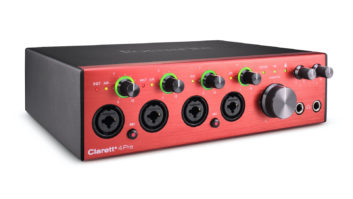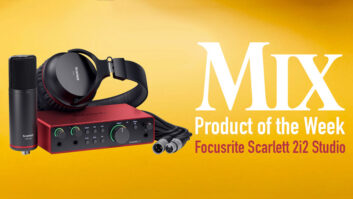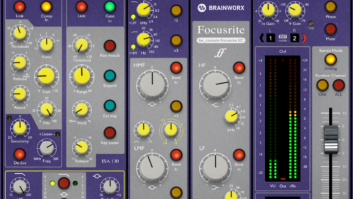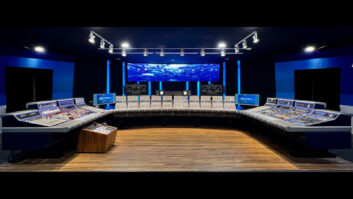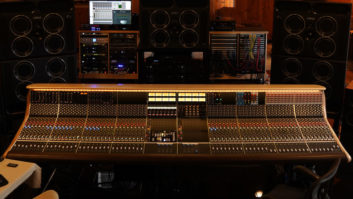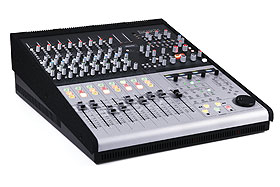
In April 2011, Focusrite Audio Engineering Ltd. and Audient Ltd. agreed to have Focusrite start the production and sale of certain Audient products. The dual-layer, small-format Focusrite Control 2802 is the first product created by both companies. Except for the new branding on the metal work and improved DAW integration, it is identical to the Audient ASP2802. The Control 2802 shares the same mic preamp topology and bus compressor design as the ASP8024, as well as many similarities to the Audient Zen console that I reviewed in Mix’s May 2010 issue.
The Focusrite Control 2802 is an analog recording console and DAW control surface in one. It makes the difficult easy by combining short and clean analog signal paths, as well as nearly limitless configuration and routing possibilities, with well-integrated workstation control.
IN CONTROL
The Focusrite Control 2802 is a 2-bus stereo mixer without equalizers nor multitrack buses. It has a wedge-shaped steel case, a built-in world power supply, and a rear panel covered with XLR, TRS and DB-25 sockets. It weighs just more than 40 pounds, measures 17.7×21.6 inches deep, and can be rackmounted in 15 spaces or placed on a desktop, as I did for this review.
It has eight 100mm Alps motor-fader channels with Solo, Cut and Select buttons that control eight THAT Corp. 2180LB VCAs. Because no analog audio passes through the faders themselves, seamless global switching between DAW and analog layers allows the faders to function as either DAW automation faders or regular line/mic input faders for manually “riding” levels, etc.

The rear panel is covered with XLR, TRS and DB-25 sockets,
The eight channels each have processor inserts (rear panel TRS jacks) with in/out switches and, along with the eight in-line cue inputs, are sourced from either the eight DAW inputs (DB-25) or the eight (TRS) line inputs or eight (XLR) Class-A microphone preamps via the individual mic/line switches.
Each channel has a DAW button that individually “flips” the fader’s source between the DAW inputs and the mic/line signals. With the DAW button down, pushing the Alternate Input switch routes the line/mic signal to the stereo cue mixer.
Both channels and cue signals are individually assignable to the stereo mix bus for up to 16 inputs to mix. By adding 16 additional inputs, I was set up for summing/mixing 16 stereo pairs or 32 tracks from my Pro Tools|HD rig.
For recording to your DAW, the channels and cue signals are also individually assignable to the eight direct outputs (DB-25). Using a combination of four switch positions, direct outs can exit the console post-fader, pre-insert, pre-fader or in Channel mode—directly out of the mic pre section—which is my choice for all mic pre testing. All of the 2802’s inputs, outputs and insert send/returns are balanced +4dBu lines.

MIC PREAMPS
The 2802’s mic preamps feature a hybrid design with a discrete front end and chip line driver. They each have switchable +48-volt phantom power; a smooth-sounding 75Hz, 12dB/octave highpass filter; and a polarity/phase-flip button.
While recording male vocals, I compared one of the 2802’s eight mic pre’s with my RTZ Professional Audio 9762 dual-combo mic pre. I used my transformer mic-splitter box (Jensen JT-MB-E inside) to route a large-diaphragm condenser mic to both pre’s at the same time. I used the 2802’s superclean Channel mode preamp output and then ran the RTZ’s line out into an adjacent line-input channel on the 2802; in this way, I could match levels and route both signals out the direct outputs to Pro Tools|HD.
It was amazing how close both pre’s sounded: quiet, warm and solid, and exactly as I remember the sound of the pre’s in the Audient Zen console—fantastic! I would only say that the RTZ had more gain available and was more open-sounding. On the 2802, there is up to 15dB additional gain available using the Channel Trim control if you select the post-fader direct output path. Over the course of the nearly three weeks that I had the Control 2802, its mic pre’s performed perfectly for recording all sources.
MONITORING
About one-third of the 2802’s surface is dedicated to professional and comprehensive monitoring facilities. Between the mix bus and other signals, there are main monitoring and cue source selection, plus external sources such as an 1/8-inch jack for an iPod. There is a headphone cue level, main volume with adjustable dim and cut buttons, alt/main speaker select (two pairs of XLRs) and a built-in talkback mic with level control or you may connect an external mic (XLR).
The Channel Solo button, along with the Solo mode button and Solo/Mix Blend control in the monitor section, designate the four analog solo modes: AFL, PFL, SIP (Solo-In-Place) and SIF (Solo-In-Front). There is also SIP Safe, a way to isolate any channel from muting. In the DAW layer, the eight Channel Solo and Mute buttons follow the bank selected in Pro Tools.
I found the monitoring section to be transparent. The mix playing through my KRK ERGO monitoring-correction unit sounded the same whether connected directly to the 2802’s stereo bus outs or its stereo monitor outs.
THE SUM OF ALL CHANNELS
Using two Avid Pro Tools|HD 192 I/O boxes (with 16 output channels each), I took an existing “in-the-box” mix in Pro Tools and stemmed it out to 32 outputs. For the first 16 outputs I wanted panning facilities, so I used the channel and alternate input cue paths, each of which have pan pots.
For the next four stereo pairs, I used the 2802’s fixed-level summing input (DB-25), which equally sums the odd-numbered tracks to the left side of the stereo bus and the even tracks to the right. This was perfect for stereo tracks in the mix that rarely changed, such as effect returns, synth pads or for a one-time piano solo during the song’s bridge.
For the last eight tracks, I used the 2802’s two effects stereo returns for two stereo stems, and I enlisted the fixed-level DAW mix input (XLRs) and main mix insert return (TRS) for the last two stereo pairs.
Actually, the DAW mix input is for playing out a stereo mix directly from your DAW. That way, when tracking or overdubbing, the channel faders are free for riding mic levels and the cue mixer will provide a zero-latency mix of those channels’ recording inputs.
ALIGNED FOR MIX
To align the 2802’s 32 inputs, I sent a -18dBFS test tone out through Pro Tools’ 32 outputs and set each stem to contribute 0 dB to either the left or right side of the mix bus, as measured on the console’s 20-segment LED bar-graph peak stereo bus meter. The meter is calibrated to read 0 VU = +4 dB and has a 36dB range. The stereo master fader was set all the way up; it’s a 100mm Alps nonmotorized fader without a VCA.
In the analog layer when the Select mode is active and the Unity button is on, pushing any of the Select buttons above the channel faders caused them to “slew” to unity gain instantly—very handy for this setup process. Furthermore, the Channel Trim knobs all aligned perfectly on their detents, indicating good design, manufacturing quality and tight circuit-component tolerances. To check and set unity accurately on the summing, DAW mix and mix insert returns, you’ll have to individually solo (inside Pro Tools) each of those 16 tracks.
AUTOMATION
The 2802’s DAW layer uses HUI protocol and will play nicely with Logic 9, Cubase 5, Nuendo and Pro Tools using its upgraded software/firmware. The console connects to your computer via a standard Cat-5e cable, or in this case to my hub. I downloaded and installed the latest Control 2802 driver and followed all of the manual’s instructions. After a restart, the console interfaced my rig the first time.
The console has analog automation on the eight channel faders. To set this up, in Pro Tools I opened eight MIDI channels and then immediately hid them so as to not take up mixer screen real estate. Next I went to Pro Tool’s Setup > Peripherals > MIDI Controllers and selected HUI and the predefined Receive/Send to Focusrite Control 2802 Control Surface paths.
The lower-right quadrant of the 2802’s surface is the DAW Control Surface panel with a blue-colored OLED and four multifunction data-entry encoders. In Setup mode, the OLEDs and encoders are for setting network parameters, the host DAW and showing console firmware info.
In the DAW layer, the OLEDs show the name and pan position of each track in Pro Tools (four at a time), aux sends A through E levels (only), and other parameters. Operational/editing shortcuts that your particular DAW allows over HUI are supported with solid-feeling controls and buttons, plus you can download DAW-specific manuals to configure and get the most out of the DAW layer.
The Select mode section defines the operation of the Channel Select switches for specific tasks in the DAW or analog layers. In Pro Tools, you can select tracks from any of the eight channels as they bank across Pro Tools’ mixer; you can page-left/right, record-enable and auto-safe.
There are also four user-programmable function keys, and I was okay with the default values: toggle Pro Tools’ Edit/Mix windows, open/close the currently selected plug-in, and switch Pro Tools’ Transport window on/off. I also liked using the 2802’s onboard transport buttons and jog/shuttle wheel.
MIXING FOR REAL
I found 32 stem outputs an optimum working number of sources to mix. I had enough flexibility to separate out important elements such as kicks and snares, guitar “wire choirs,” and lead and backing vocals. All of my plug-in effect returns, now routed to the 2802’s fixed inputs, sounded better because the board is quiet and transparent enough that I could hear reverb tails and long delays evolve to their actual endings; for whatever reason(s), I don’t always find that “in the box.”
I liked that Solo and Mute buttons are instant on the 2802, and all other Mute buttons on the console flash when a solo is pushed anywhere. The OLED shows the panning positions of the eight main fader channels, and the DAW Meters button changes the channel meters from reading input levels over to the DAW tracks’ levels.
I found the THAT Corp. 2180LB VCA-based stereo mix bus compressor was excellent across the mix bus in moderation and useful when patched externally using the rear panel TRS jacks. The wet/dry knob, complete set of controls and good metering facilities on this vibey compressor allow for subtle mix leveling, all the way to applying a good squash to drum submixes for effect.
SO MUCH, SO LITTLE
The Focusrite Control 2802’s diminutive size might fool the casual observer, but I found it to be everything I could want and more. This is a powerful and deep system, so there is a slight learning/acclimation curve, as well as wiring/configuration decisions to be made. But because the whole architecture is understandable, intuitive and malleable, I found the time well-spent learning it.
Just as when I reviewed the Audient Zen, the sound of my mixes took a quantum leap in clarity, vividness and stereo width. Unfortunately, hearing the song’s improved tonality caused me to rethink nearly everything I had already done in the box—equalization, panning, effects, etc. The Control 2802 also comes with Focusrite’s Midnight and Forté plug-in suites, dynamics and equalizers modeled on the original Focusrite hardware designs that are accessible from the DAW layer of the console. From now on, I want to mix only this way!
Barry Rudolph is an L.A.-based engineer.

Click on the Product Summary box above to view the Focusrite Control 2802 product page.
